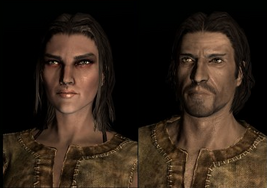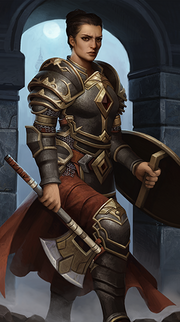
Female (left) and Male (right) Imperials in The Elder Scrolls V: Skyrim
Imperials, also known as Cyrodilics[source?] or Cyrodiils,[1] are a race of men from Cyrodiil, the province in the center of Tamriel. Members of the Imperial race are some of the most well-educated, wealthy, and well-spoken people in Tamriel.[source?] Natives of the civilized cosmopolitan province of Cyrodiil, they have proved to be shrewd diplomats, traders,[2] and tacticians.[3]
By game
- Imperial (Morrowind)
- Imperial (Oblivion)
- Imperial (Skyrim)
- Imperial (Skyrim enemy)
- Imperial (Online)
- Imperial (Legends)
- Imperial Legion, a faction commonly referred to as "The Imperials."
Cyrodiil

Imperial card art from The Elder Scrolls: Legends.
- Main article: Cyrodiil
Cyrodiil is the cosmopolitan heartland of Tamriel. It has served as the seat of power for several major empires, such as the Alessian Empire, the Reman Empire, and the Septim Empire, and as such is commonly known as simply, "The Imperial Province."[4] It is home to the Imperial City where the Emperor and his Elder Council live and rule.[1]
Physiology
Imperials can be differentiated from Bretons and Nords by their fair to swarthy skin, as opposed to the typically fairer complexion of Bretons and Nords. However, Imperial skin tone is not as dark as that of Redguards. Imperials also have slightly sharper faces than other races of men. They are descendants of the native Nedic and other Proto-Cyrod peoples that were enslaved by the Ayleids.[5][4]
The phrase "Imperial Race" is a bit of a misnomer. The people of Cyrodiil are divided into two ethno-cultural groups: Nibeneans and Colovians. Both descended from the native Nedic and Cyro-Nordic peoples that were enslaved by the Ayleids, but diverged a bit after consecutive invasions and interactions with other races. Colovian Imperials in Western Cyrodiil are more Nordic, sharing similar beliefs such as a heavy martial and seafaring tradition. Nibeneans have an Akaviri and, to a lesser degree, Elven heritage. They have a greater appreciation for magic, art, commerce, and spirituality, in spite of being staunchly loyal to Alessian traditions. Both groups reflect the Empire's culture: a hybrid of Nordic, Aldmeri, and Akaviri culture.[citation needed]
History
First Era
- "Cyrodilic history truly begins by the middle of the Alessian Reformation, when civilization and cultivation had allowed the region to emerge as a discernible Tamrielic power."
- ―Imperial Geographic Society[src]
Imperials, like any race, have had their share of both internal and external conflicts in their native homeland. Due to relatively frequent invasions from various Elven civilizations and simply Cyrodiil's sheer size, unification of the region as a whole was proven a difficult task.[1]
The earliest known Empire in Cyrodiil was the Empire of the Ayleids, which had ruled since before recorded history. The Fall of White-Gold Tower in 1E 243 is the year generally associated with the end of Ayleid rule over humans in Cyrodiil.[6] In the same year of Alessia's rebellion came the Alessian Empire, created by the former human slaves of the Ayleids, including Alessia.[7] The Empire, alongside the monotheistic religion that had grown to prominence during the same time, the Alessian Order, eventually collapsed in a war known as the War of Righteousness.[1]
Naming conventions
Imperial characters often have Latin names. Examples include, Sorex Vinius, Tullius, Camilla Valerius, Cicero, etc., keeping with the overall Roman characteristics. However, starting with Skyrim, some Imperial names start to sound more Italian than Latin such as Viola Giordano, Severio Pelagia, Marcurio or Vittoria Vici, reflecting the change in language over time.
Society and culture
The people of Cyrodiil are divided into two ethno-cultural groups: Nibeneans and Colovians. The Colovians are the Imperials of the West and are respected as Cyrodiil's iron hand: firm, unwavering, and ever-vigilant. Their primitive ferocity was disinclined to magic or the need for industry, preferring bloody engagement and plunder instead. They still possess much of the frontier spirit of their ancestors. They are uncomplicated, self-sufficient, hearty, and extremely loyal to one another. Whenever the East would tremble under the weakness of a leader, the Colovians would withdraw unto themselves, always believing they were keeping the national spirit safe until the storm passed. They realize that the Nibenay Valley is the heart of the Empire and the cultural center of its civilization, but it is a fragile center that only can be held together by the strength of character of its Emperor. When he falters, so do the Colovians. Yet when he is mighty, like Tiber Septim, they are his legions. Today, West Cyrodiils make up the majority of the soldiers in the Ruby Ranks. The Colovian nobility, all officers of the Imperial Legions or its West Navy, do not allow themselves the great expenditure of courtly life as is seen in the capital city. They prefer immaculate uniforms and stark standards hanging from the ceiling of their austere cliff-fortresses.[1]
The Imperials of the East are the Nibeneans and they inhabit the East of the Nibenay Valley. The Nibeneans are regarded as Cyrodiil's soul: magnanimous, tolerant, and administrative. It was in the rain forests of the Nibenay Valley that the original Cyro-Nordic tribes, the Nibenese, learned a self-reliance that separated them culturally and economically from Skyrim. The Elven harassment of the First Empire gave rise to an elite form of support troop for the Valley armies that still serves a prominent role in Cyrodiil today: the battlemage. In contrast to the Colovians of the West, the Eastern people of Cyrodiil relish in garish costumes, bizarre tapestries, tattoos, brandings, and elaborate ceremony. Closer to the wellspring of civilization, they are more given to philosophy and the evolution of ancient traditions. The Nibenese find the numinous in everything around them, and their different cults are too numerous to mention (the most famous are the Cult of the Ancestor-Moth, the Cult of Heroes, the Cult of Tiber Septim, and the Cult of Emperor Zero). To the Colovians, the ancestor worship and esoteric customs of the East can often be bizarre. Akaviri dragon-motifs are found in all quarters, from the high minaret bridges of the Imperial City to the paper hako skiffs that villagers use to wing their dead down the rivers. Thousands of workers ply the rice fields after the floodings, or clear the foliage of the surrounding jungle in the alternate seasons. Above them are the merchant-nobility, the temple priests and cult leaders, and the age-old aristocracy of the battlemages.[1]
Since the rise of Reman Empire, the Imperials have took it upon themselves to act as the guardians of the northern human kingdoms at large. Some neighboring provinces, particularly the elves of Summerset Isles, believe this to be an excuse to justify the Empire's renewed imperialism.[1] The rise of the Septim Empire continued where the Reman Empire left off and continued the Third Empire's expansion of influence. The Third Empire's conquests culminated in the beginning of the Third Era, when Tiber Septim brought peace to Tamriel in 2E 896 by conquering all of the known world.[8]
The Imperials had identified with many religions and the dynamic changes of power in the Nibenay Valley has evolved many of them and shifted the primary religions that come into prominence. In contemporary times, the Imperials worship the Eight Divines. After the rise and death of Tiber Septim, a cult acknowledged that Tiber Septim apotheosized into the god called Talos and the Eight Divines became the Nine Divines.[9] In the Fourth Era, the Empire of Cyrodiil went to war with the Aldmeri Dominion in the Great War. Only by signing the peace treaty known as the White-Gold Concordat was the Empire able to survive the onslaught of the high elven Aldmeri Dominion, and thus end the Great War.[8] Following the signing of the White-Gold Concordat, Talos was effectively removed from the pantheon of the Gods—and The Eight Divines worship resumed. Where required, Thalmor agents from the Aldmeri Dominion, ensure that the worship of Talos remains an illegal activity.[10] Emperor Titus Mede II stated in a publication that mortal men such as Talos were never meant to achieve apotheosis. It is for this very reason that the Emperor, and indeed the Empire itself, recognizes that allowing the worship of Talos was a mistake and publicly declares its support of removing Talos worship from Tamriel. It is unknown if whether this public renunciation of Talos' divinity is an act to appease the Thalmor or if this is the Emperor's sincere belief.[11]
Notable Imperials
- Abnur Tharn
- Acilius Bolar
- Alessia
- Fortunata ap Dugal
- Gratian Caerellius
- Lucien Lachance
- Martin Septim
- Pelinal Whitestrake
- Potema Septim
- Reman Cyrodiil III
- Ria Silmane
- Teo Bravillius Tasus
- Titus Mede II
- Torradan ap Dugal
- Tullius
- Uriel Septim VII
- Varen Aquilarios
References
- ↑ 1.0 1.1 1.2 1.3 1.4 1.5 1.6 Pocket Guide to the Empire, First Edition: Cyrodiil
- ↑ The Elder Scrolls IV: Oblivion Official Game Guide
- ↑ Imperial (Legends)
- ↑ 4.0 4.1 Pocket Guide to the Empire, Third Edition: Cyrodiil
- ↑ The Adabal-a.
- ↑ The Last King of the Ayleids
- ↑ Pocket Guide to the Empire, Third Edition: Eras
- ↑ 8.0 8.1 Loading Screens (Skyrim)
- ↑ Dialogue with The Prophet
- ↑ The Great War
- ↑ The Talos Mistake
